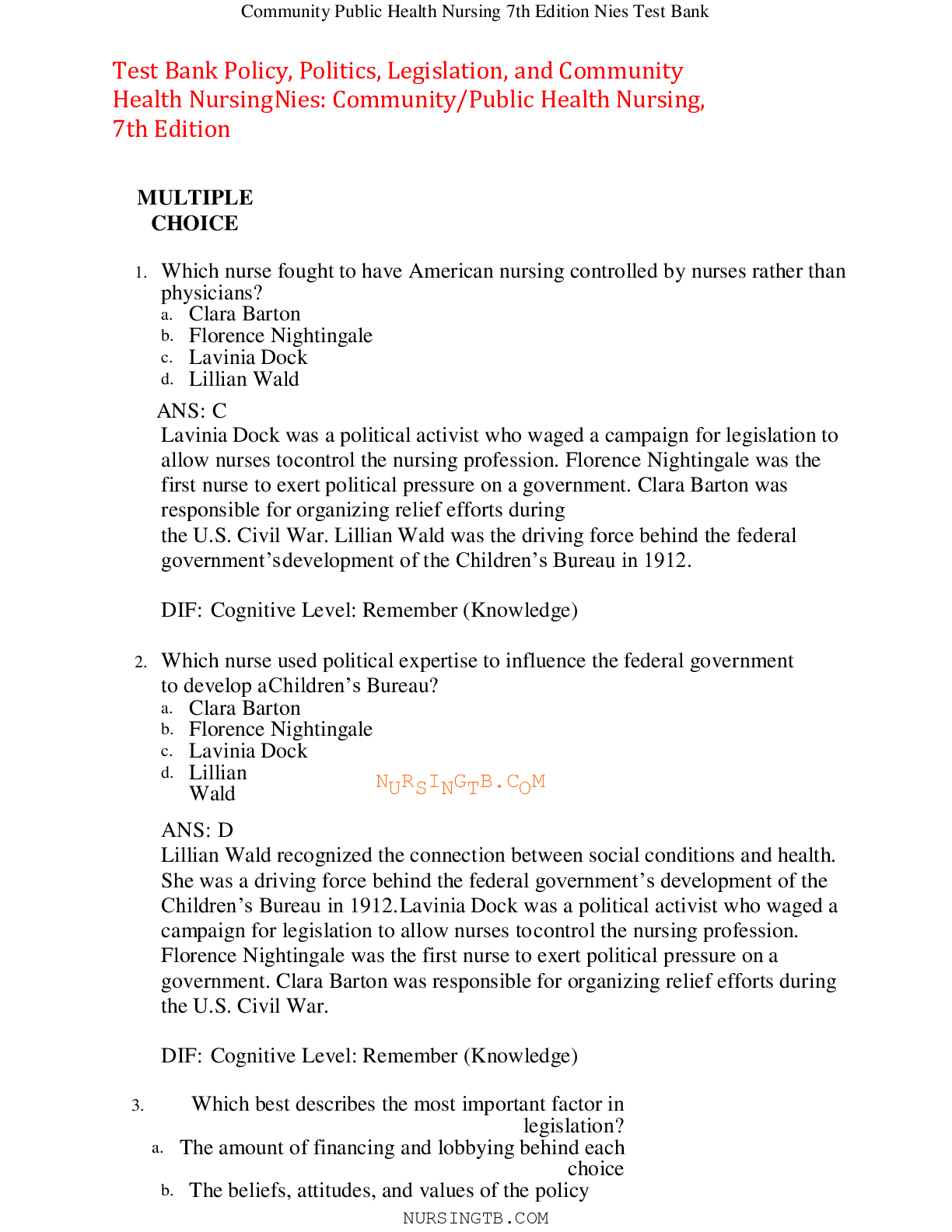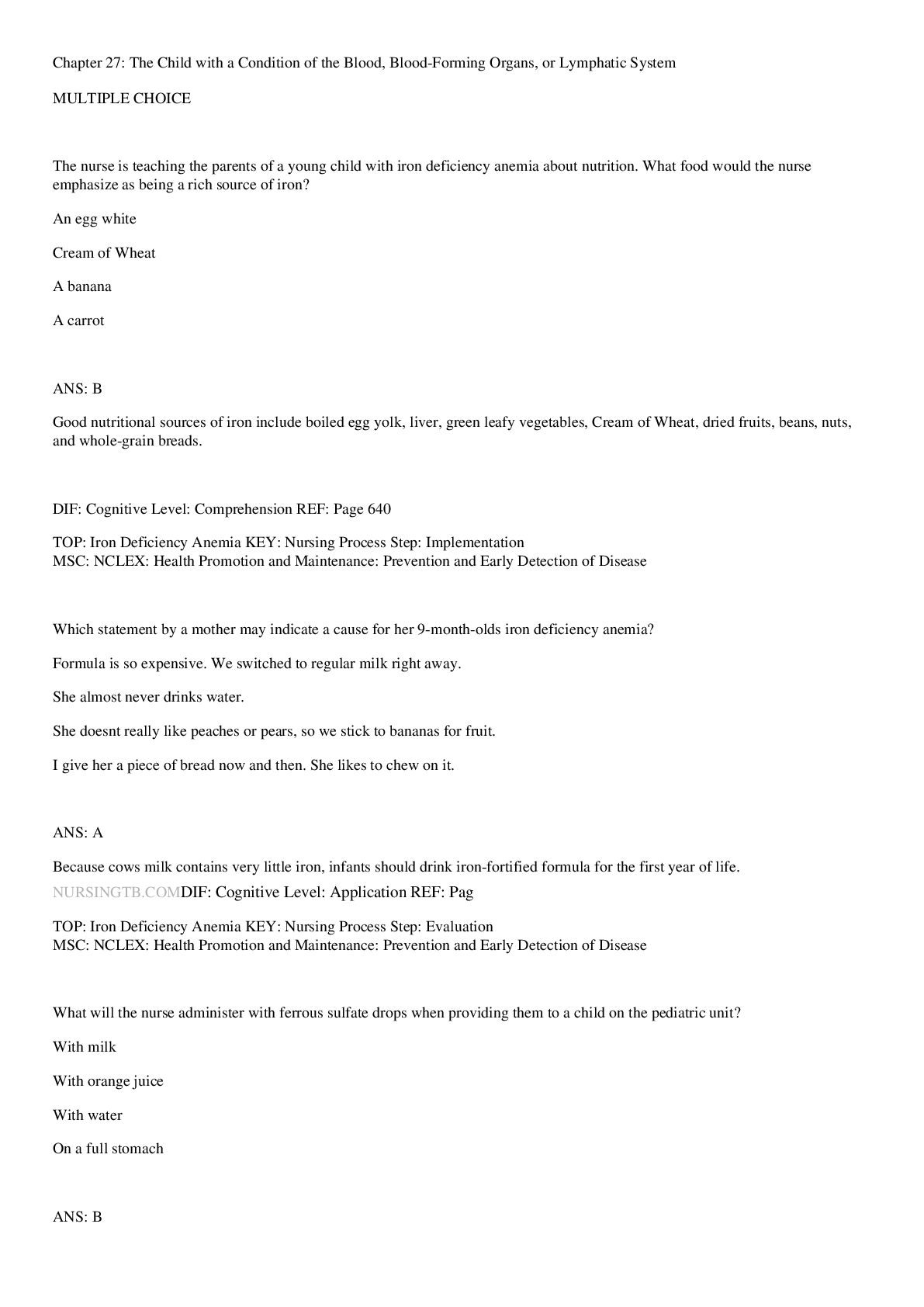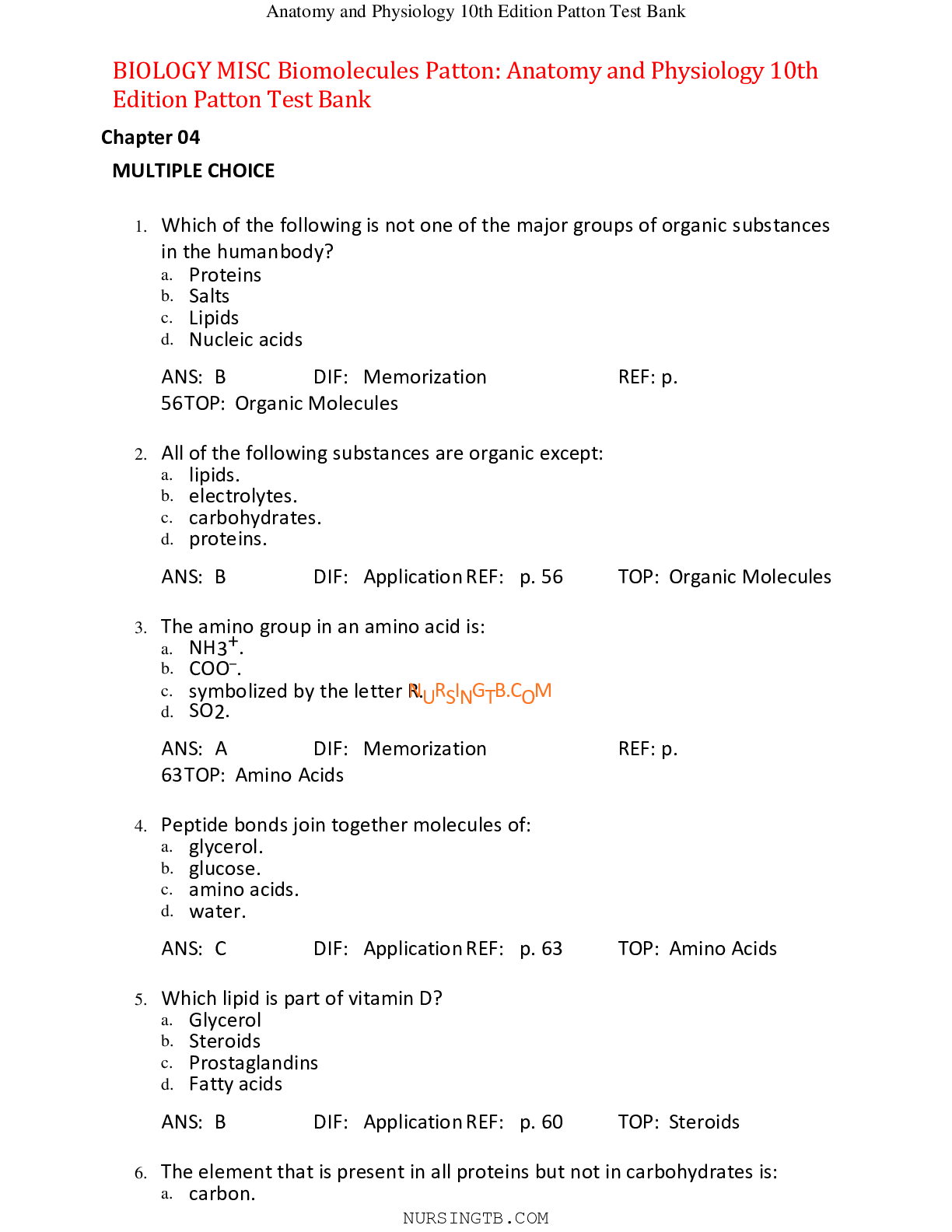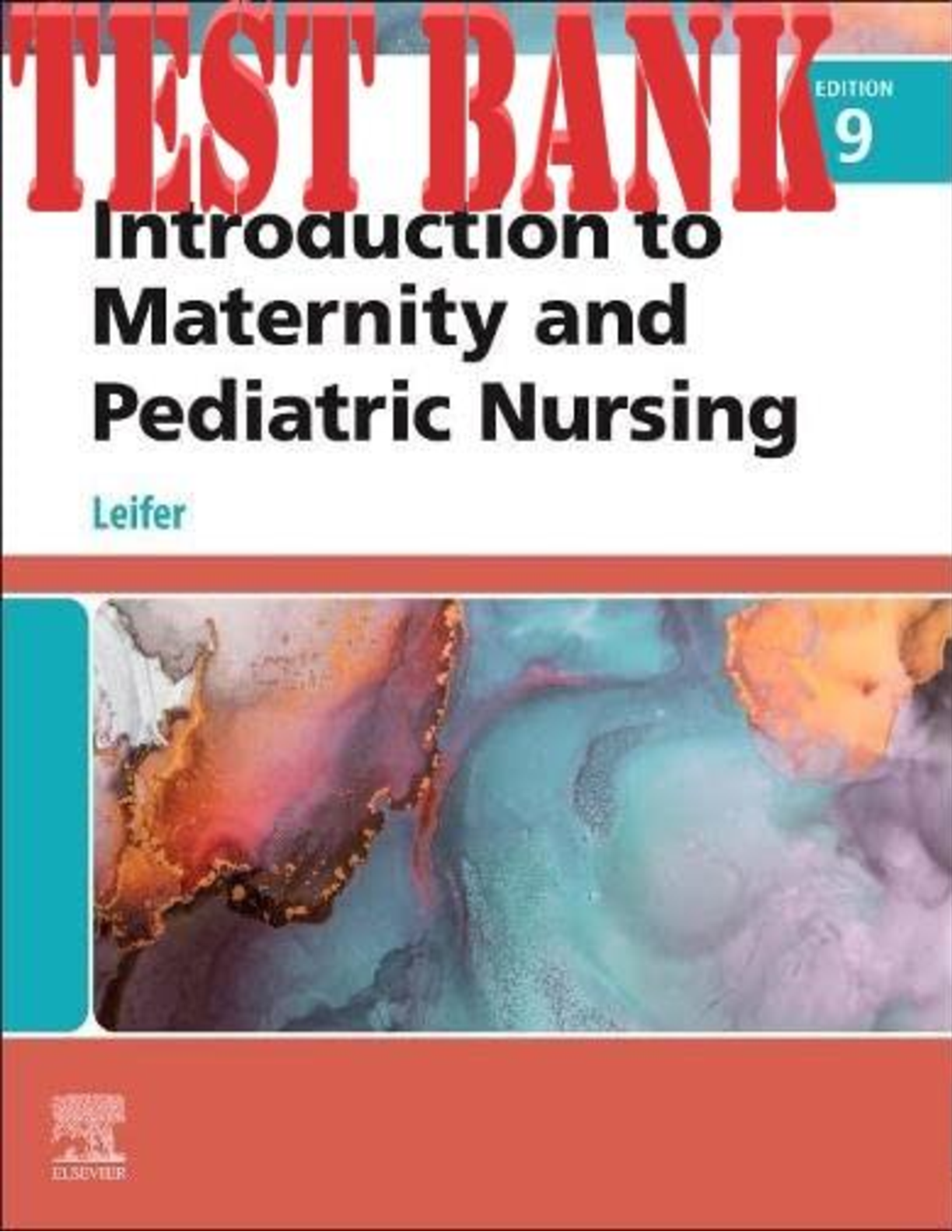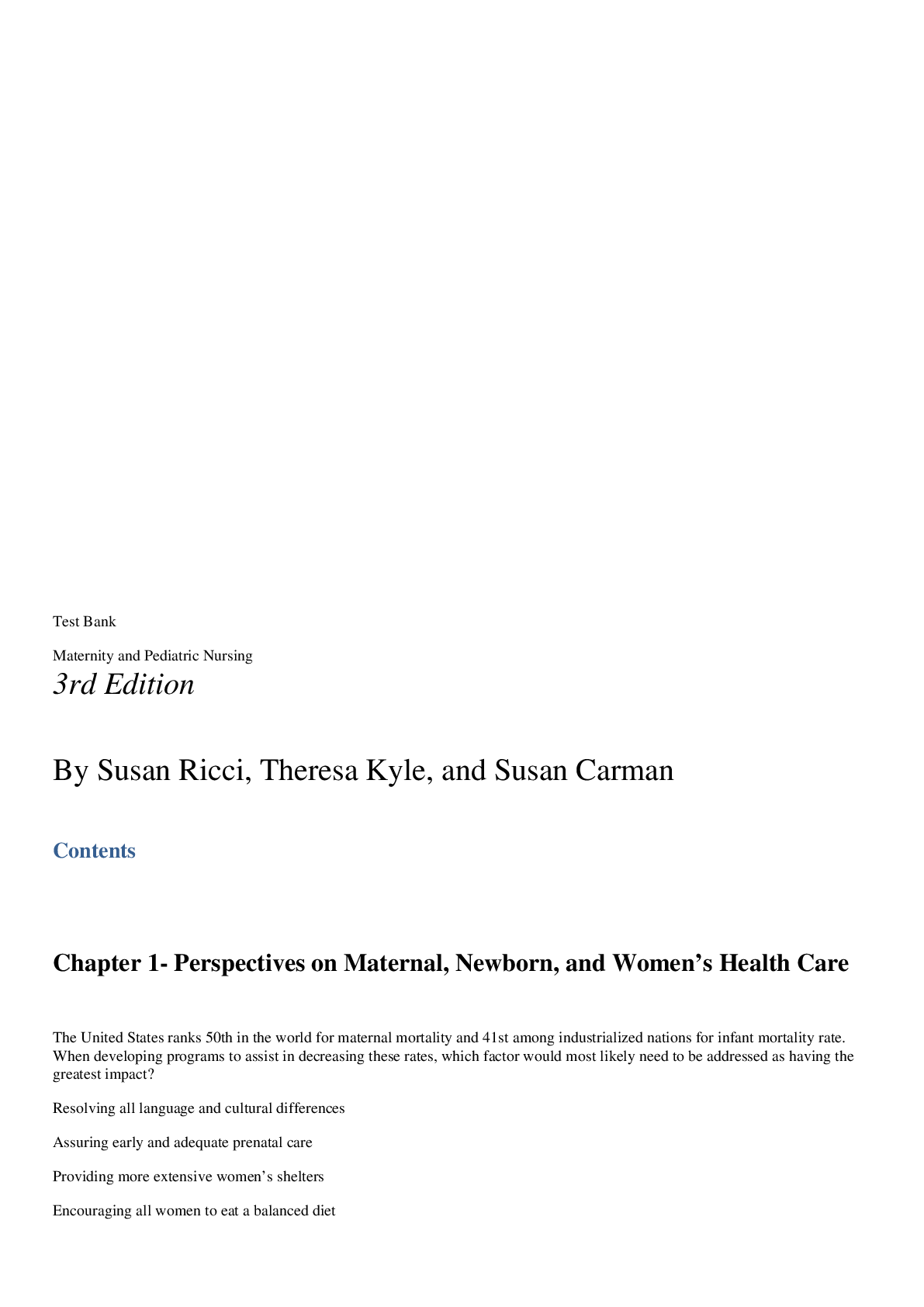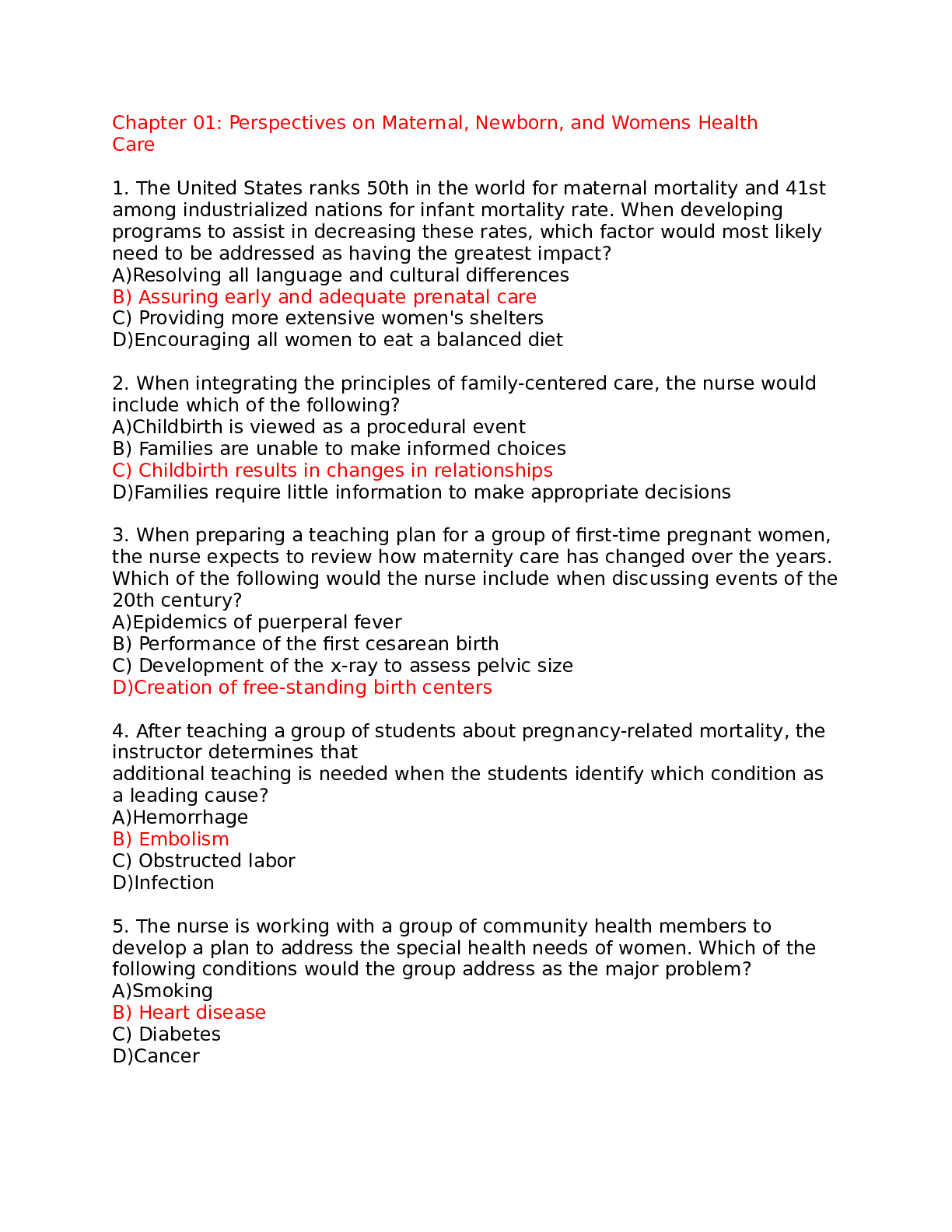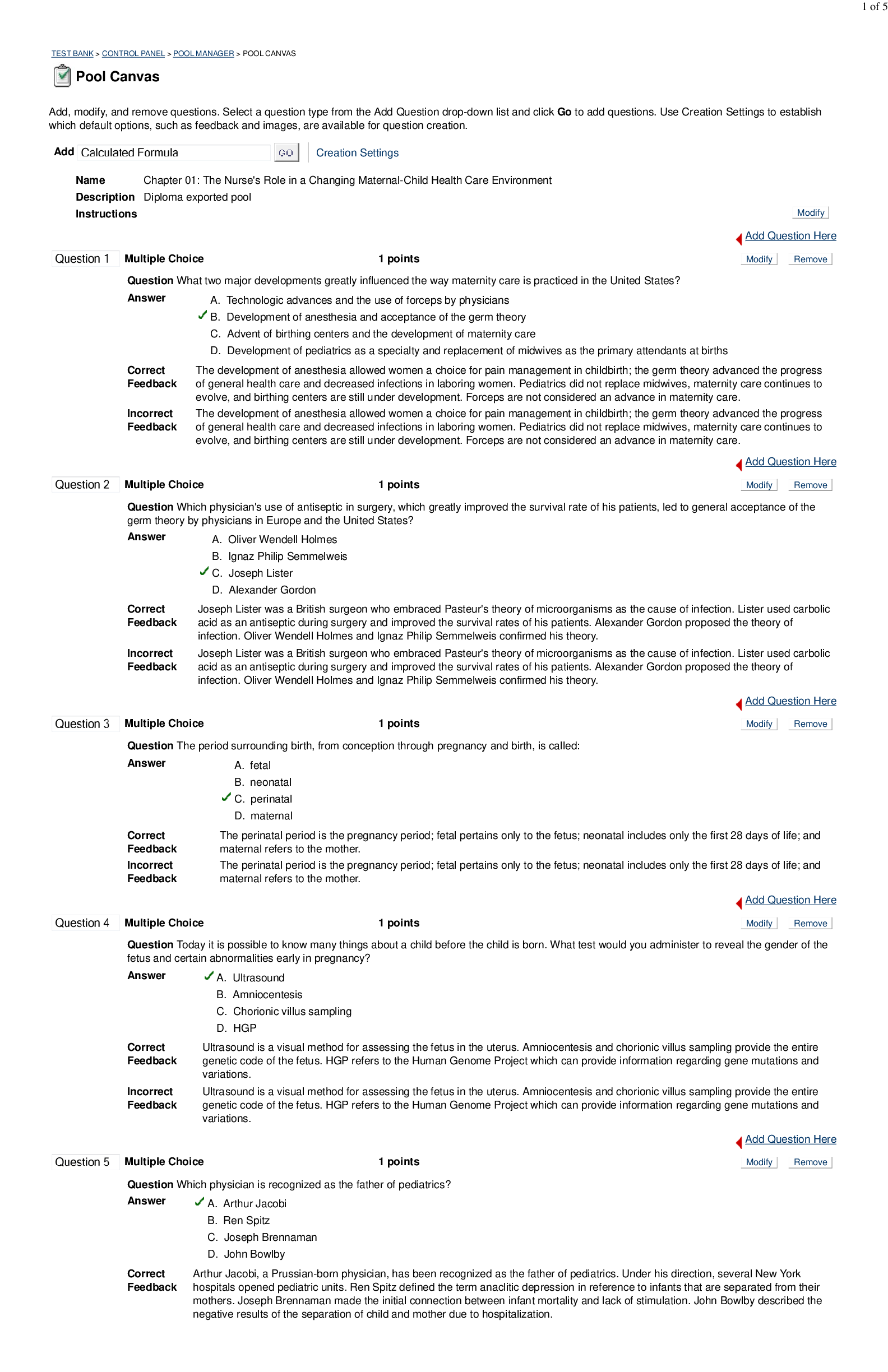*NURSING > TEST BANK > Test Bank - Introduction to Maternity and Pediatric Nursing 8e (by Leifer)The Toddler,100% CORRECT (All)
Test Bank - Introduction to Maternity and Pediatric Nursing 8e (by Leifer)The Toddler,100% CORRECT
Document Content and Description Below
Test Bank - Introduction to Maternity and Pediatric Nursing 8e (by Leifer)The Toddler MULTIPLE CHOICE 1. Which behavior reported by a parent of an 18-month-old toddler would the nurse report to th... e pediatrician as a cause for concern? a. Has temper tantrums b. Feeds self sloppily c. Walks by holding onto furniture d. Speaks in short sentences ANS: C By 18 months, a toddler should have been walking alone for several months. The toddler who walks holding onto furniture should be evaluated by a developmental specialist. DIF: Cognitive Level: Analysis REF: Page 413 OBJ: 2 TOP: Delayed Walking KEY: Nursing Process Step: Data Collection MSC: NCLEX: Health Promotion and Maintenance: Growth and Development 2. What would the nurse assessing growth and development of a 2-year-old child expect to find? a. The child jumps with both feet. b. Twenty deciduous teeth have erupted. c. The child can hop on one foot. d. The child has a vocabulary of 900 words. ANS: A The 2-year-old can jump with both feet. The remaining achievements occur after 2 years of age. DIF: Cognitive Level: Comprehension REF: PNaUgeRS4I1N3GTB.COM OBJ: 2 TOP: Jumping KEY: Nursing Process Step: Data Collection MSC: NCLEX: Health Promotion and Maintenance: Growth and Development 3. A parent remarks, My 18-month-old daughter carries her blanket around everywhere. Is this normal? What is the best explanation a nurse who has an understanding of toddler development might give? a. She carries her blanket because she is ritualistic. b. Carrying her favorite blanket is self-consoling behavior. c. This behavior can be discouraged by offering new toys to the child. d. This could be indicative of emotional distress. ANS: B Favorite possessions and repetitive rituals are self-consoling behaviors for the toddler. DIF: Cognitive Level: Application REF: Page 412 OBJ: 6 TOP: Self Consoling KEY: Nursing Process Step: Implementation MSC: NCLEX: Health Promotion and Maintenance: Growth and Development 4. The nurse observed three toddlers playing side by side with dolls. Closer observation revealed that the children were not interacting with one another. What type of play is this? a. Solitary b. Parallel c. Associative d. Cooperative ANS: B Toddlers engage in parallel play. Children play next to, but not with, each other. DIF: Cognitive Level: Comprehension REF: Page 424 TOP: Play KEY: Nursing Process Step: Data Collection MSC: NCLEX: Health Promotion and Maintenance: Growth and Development 5. What instruction would the nurse include when planning anticipatory guidance for parents of a toddler? a. Adhere to a rigid schedule because the toddler is ritualistic. b. Limit-setting should include praise. c. Shoes should fit snugly at the toe and arch. d. Dress the toddler in pants with a zipper so that he or she can learn to zip and unzip clothes. ANS: B Limit-setting should include praise as well as disapproval for undesired behavior. DIF: Cognitive Level: Application REF: Page 416 TOP: Limit Setting KEY: Nursing Process Step: Planning MSC: NCLEX: Health Promotion and Maintenance: Growth and Development 6. What is the best advice the nurse can offer a parent concerned because her 2-year-old is very active and does not eat much? a. Insist that the child eat one food on the plate. b. Help the child wind down with a quiet activity before mealtime. c. Maintain a consistent eating schedule for the family. d. Serve the meal with a variety of interesting plates, cups, and utensils. ANS: B Quiet time before meals provides an opportunity for the active toddler to wind down. DIF: Cognitive Level: Application REF: Page 419 TOP: Quiet Time KEY: Nursing Process Step: Implementation MSC: NCLEX: Health Promotion and Maintenance: Growth and Development NURSINGTB.COM 7. How would the nurse advise a parent who states, I never know how much food to feed my child? a. Serving sizes should not exceed 1 teaspoon of each type of food. b. Food quantities must be carefully measured to avoid overfeeding. c. Use 1 tablespoon of each food for each year of age as a guideline. d. A toddler should eat three balanced meals. Snacks are not necessary. ANS: C A tablespoon of each type of food for each year of age is a good guideline to follow when determining serving sizes. DIF: Cognitive Level: Application REF: Page 419 TOP: Food Portions KEY: Nursing Process Step: Implementation MSC: NCLEX: Health Promotion and Maintenance: Growth and Development 8. The nurse is discussing toilet training with parents. What behavior by the child would identify toilet training readiness? a. Willing to sit on the potty for 15 to 20 minutes b. Dry in the daytime for 4-hour periods c. Able to communicate that he or she is wet d. Curious about bathroom activities ANS: C Children are ready for toilet training when they can communicate in some fashion that they are wet or need to urinate or defecate. DIF: Cognitive Level: Comprehension REF: Page 417 OBJ: 8 TOP: Toilet Independence KEY: Nursing Process Step: Implementation MSC: NCLEX: Health Promotion and Maintenance: Growth and Development 9. What is the most appropriate toy for the nurse to select for a normal 2-year-old child? a. Bicycle with training wheels b. Dump truck c. Wind-up toy d. Building block set ANS: B The 2-year-old enjoys playing with objects that can be pushed or pulled. DIF: Cognitive Level: Application REF: Page 424 TOP: Toys and Play KEY: Nursing Process Step: Data Collection MSC: NCLEX: Health Promotion and Maintenance: Growth and Development 10. What could the nurse recommend to a childs mother to encourage a toddler to practice independence? a. Offer a variety of items to choose from to stimulate his mind. b. Allow the child to determine his own daily routine. c. Offer him a choice between two items. d. Set the routine herself, but discuss with her toddler how he or she would have done it differently. ANS: C The toddler can be allowed to make choices as the situation warrants, but the number of choices should be limited because too many confuse the toddler. DIF: Cognitive Level: Application REF: Page 412 TOP: Offering Choices KEY: Nursing Process Step: Implementation MSC: NCLEX: Health Promotion and Maintenance: Growth and Development 11. On a home visit, the nurse notes that the parents require teaching intervention to protect the 15-month-old child who lives there. What observation would lead the nurse to this conclusion? a. The fireplace has a screen. NURSINGTB.COM b. The dining room table has a tablecloth on it. c. There are paintings on the wall. d. The kitchen floor is clean but not shiny. ANS: B A tablecloth presents a safety hazard because the curious toddler will reach up and pull on it. The toddler could be injured if items on the table are moved when the tablecloth is pulled. DIF: Cognitive Level: Analysis REF: Page 421 OBJ: 10 TOP: Injury Prevention KEY: Nursing Process Step: Data Collection MSC: NCLEX: Safe, Effective Care Environment: Safety and Infection Control 12. What does the nurse consider as an appropriate snack for a 2-year-old child? a. Hot dog sections b. Grapes c. Popcorn d. Applesauce ANS: D Applesauce is a healthy and safe snack food for the toddler. The toddler is at risk for choking on foods such as grapes, hot dogs, and popcorn. DIF: Cognitive Level: Analysis REF: Page 421 OBJ: 10 TOP: Injury Prevention KEY: Nursing Process Step: Planning MSC: NCLEX: Health Promotion and Maintenance: Growth and Development 13. Which finding would concern the nurse assessing vital signs on a 2-year-old? a. Temperature of 37.1 C (98.8 F) b. Pulse at 100 beats/min c. Respirations of 36 breaths/min d. Blood pressure of 90/60 mm Hg ANS: C In the toddler period, the respiratory rate decreases to 25 breaths/min. DIF: Cognitive Level: Analysis REF: Page 414 TOP: Vital Signs KEY: Nursing Process Step: Data Collection MSC: NCLEX: Physiological Integrity: Physiological Adaptation 14. What would be an expected finding when assessing language development in a 2-year-old? a. A 900-word vocabulary b. Use of two-word sentences c. Use of pronouns and prepositions d. 100% of speech is understandable ANS: B The 2-year-old should be using two-word sentences. DIF: Cognitive Level: Analysis REF: Page 415 OBJ: 5 TOP: Speech Development KEY: Nursing Process Step: Data Collection MSC: NCLEX: Health Promotion and Maintenance: Growth and Development 15. The nurse is planning to explain the use of time-outs to the parent of a 3-year-old. How many minutes will the nurse indicate is appropriate for a child of this age? a. 3 b. 6 c. 10 d. 15 NURSINGTB.COM ANS: A Timing for time-out is usually based on 1 minute per year of age. DIF: Cognitive Level: Comprehension REF: Page 416 TOP: Guidance and Discipline KEY: Nursing Process Step: Evaluation MSC: NCLEX: Health Promotion and Maintenance: Growth and Development 16. The parent of a toddler tells the nurse, My daughters appetite has decreased. Thank goodness she loves to drink milk. What is the most appropriate response by the nurse? a. Has your daughter been sick recently? b. How much milk does she drink in a day? c. Has she become a fussy eater, too? d. Have you tried offering her finger foods? ANS: B Milk should be limited to 24 ounces a day. Too few solid foods can lead to dietary deficiencies of iron. DIF: Cognitive Level: Application REF: Page 419 TOP: Nutrition Counseling KEY: Nursing Process Step: Data Collection MSC: NCLEX: Physiological Integrity 17. How many hours should toddlers be able to stay dry for the nurse to suggest they are ready to begin bladde training? a. 1 b. 2 c. 3 d. 4 ANS: B If the toddler is mature enough to retain urine for 2 hours, bladder training can be effective. DIF: Cognitive Level: Comprehension REF: Page 418 TOP: Bladder Training KEY: Nursing Process Step: Implementation MSC: NCLEX: Health Promotion and Maintenance: Growth and Development 18. Parents tell the nurse they are frustrated with their toddlers recent behavior and refusal to agree with anything they ask of them. What does the nurse explain as the term for when a toddler tests their own power? a. Negativism b. Dawdling c. Tantrums d. Food fads ANS: A By refusing to eat, dress, sleep, or anything else by saying No, toddlers test their own power to control. Because toddlers are also egocentric, they come to believe that their negativism is absolute. This is especially true if the adults give into it. DIF: Cognitive Level: Comprehension REF: Page 412 TOP: Negativism KEY: Nursing Process Step: Implementation MSC: NCLEX: Health Promotion and Maintenance: Growth and Development 19. The nurse is assessing a 3-year-old. What is the expected weight gain for this age child? a. 2 times the birth weight b. 2.5 times the birth weight c. 3 times the birth weight d. 4 times the birth weight ANS: D NURSINGTB.COM The expected weight of a -year-old toddler is four times the birth weight. DIF: Cognitive Level: Comprehension REF: Page 412 TOP: Weight Prediction KEY: Nursing Process Step: Data Collection MSC: NCLEX: Health Promotion and Maintenance: Growth and Development 20. What guideline should an adult follow when speaking to a toddler? a. Be at eye level with the child. b. Hold by the shoulders to keep the childs attention. c. Seat the child to focus on conversation. d. Speak in a firm strong voice. ANS: A Being at eye level is helpful to hold the childs attention and is especially important when the child is frightened. DIF: Cognitive Level: Comprehension REF: Page 416 TOP: Conversing with Toddler KEY: Nursing Process Step: Implementation MSC: NCLEX: Health Promotion and Maintenance: Growth and Development 21. Why does day care for the toddler differ from that of the preschooler? a. Toddlers have a shorter attention span. b. Toddlers need more group play. c. Toddlers are less prone to environmental dangers. d. Toddlers require less outdoor space. ANS: A Toddlers have a shorter attention span than preschoolers and are prone to investigate other opportunities in the environment that may put them in harms way. Toddlers are more interested in parallel play. DIF: Cognitive Level: Comprehension REF: Page 420 TOP: Day Care KEY: Nursing Process Step: N/A MSC: NCLEX: Health Promotion and Maintenance: Growth and Development 22. A 16-month-old child is attending a well-child visit at a pediatric clinic. Which assessment would indicate the biggest cause for concern? a. Does not walk independently b. Prefers finger feeding c. Limited to single words d. Is unable to climb steps ANS: A A child should be walking independently by 16 months old. It is normal for a child this age to prefer finger feeding and to be limited to single words. Many children do not climb steps until 24 months of age. DIF: Cognitive Level: Comprehension REF: Page 413 OBJ: 2 TOP: Development KEY: Nursing Process Step: Data Collection MSC: NCLEX: Health Promotion and Maintenance: Growth and Development MULTIPLE RESPONSE 23. When selecting a potty chair, the parents are encouraged to select one that has which characteristic(s)? (Select all that apply.) a. Small enough for the childs feet to touch floor b. Sturdy and stable c. Supportive of childs back and arms d. Made of plastic or fiberglass e. Capable of being taken apart easily NURSINGTB.COM ANS: A, B, C Potty chairs should be small and sturdy and supportive of the childs back and arms. The composition is not important as long as it is stable. DIF: Cognitive Level: Comprehension REF: Page 418 TOP: Potty Chairs KEY: Nursing Process Step: Implementation MSC: NCLEX: Health Promotion and Maintenance: Growth and Development 24. The nurse suggests offering which food(s) to support the toddlers desire to self-feed? (Select all that apply.) a. Pureed foods b. Finger foods c. Foods served cold d. Foods in colorful dishes e. Foods that are varied and colorful ANS: B, D, E Finger foods that are varied and colorful and served in colorful dishes at a moderate temperature are all attractive. Foods can be chopped into small pieces but not pureed. DIF: Cognitive Level: Comprehension REF: Page 419 TOP: Self-Feeding KEY: Nursing Process Step: Implementation MSC: NCLEX: Health Promotion and Maintenance: Growth and Development 25. The nurse points out which physiological change(s) in the toddler that serve(s)as protection against disease? (Select all that apply.) a. Toughening of the skin b. Increased capillary response for thermoregulation c. Stabilization of body temperature d. Elevation in white blood cell count e. Enlarged adenoids and tonsils ANS: A, B, C, E With the exception of an increased white blood cell (WBC) count, which is always pathological, the other options are all maturing changes that equip the toddler to better fight disease. DIF: Cognitive Level: Comprehension REF: Page 413 TOP: Physiological Changes KEY: Nursing Process Step: Implementation MSC: NCLEX: Health Promotion and Maintenance: Growth and Development 26. Parents of a toddler are discussing the emotion of fear with the pediatric nurse. What information can the nurse offer regarding fear and the toddler? (Select all that apply.) a. Stress increases fear. b. Rituals help deal with fear. c. Teasing the child can decrease fear. d. Once fear is learned it is difficult to eliminate. e. Adults should openly share their fears. ANS: A, B, D Once a fear has been learned, it is more difficult to eliminate. Clinging to favorite possessions and repetitive rituals are self-consoling behaviors for the toddler, particularly at bedtime and during separation from parents. Stress increases fear of separation. Adults should attempt to control their own fears in the presence of young children. Respect and understanding should always be accorded to children who are afraid. Making fun of the fear or shaming the child in front of others is detrimental to self-esteem. DIF: Cognitive Level: Comprehension REF: Page 416 TOP: Fear KEY: Nursing Process Step: ImpleNmUeRntSaItNioGnTB.COM MSC: NCLEX: Health Promotion and Maintenance: Growth and Development COMPLETION 27. The nurse assessing a 2-year-old is satisfied to see that the present weight of the child is the birth weight. ANS: triple The birth weight has usually tripled by the time the child is 2 years of age. DIF: Cognitive Level: Comprehension REF: Page 412 TOP: Tripled Birth Weight KEY: Nursing Process Step: Data Collection MSC: NCLEX: Health Promotion and Maintenance: Growth and Development 28. The nurse explains that with the completion of myelination, the toddler will have the neuromuscular maturity to attain or control. ANS: bowel, bladder With the mature myelin, the toddler is able to translate neural impulses and respond in a significant manner. With myelination, the toddler can now translate the feeling of a full bladder or bowel and respond by defecating or urinating at willhopefully in the bathroom. DIF: Cognitive Level: Comprehension REF: Page 413 TOP: Myelination KEY: Nursing Process Step: Implementation MSC: NCLEX: Health Promotion and Maintenance: Growth and Development 29. The nurse recognizes that when the toddler claims everything in the environment as mine, it is an example of the toddler trait of . ANS: egocentrism Toddlers are egocentric in that they perceive their world only as it applies to them, such as MY mommy, MY dog, MY car, MY house, MY street. As they mature and have more experience with the world, they come to a more realistic viewpoint. DIF: Cognitive Level: Comprehension REF: Page 424 OBJ: 2 TOP: Egocentrism KEY: Nursing Process Step: Data Collection MSC: NCLEX: Health Promotion and Maintenance: Growth and Development 30. When the previously potty-trained 3-year-old wets the bed after admission to the hospital, the nurse assesses this event is caused by a related to the new environment. ANS: regression Regression occurs when a situation causes the person to go back to a less mature manner of coping. Faced with the new situation, in this case a hospital admission, the toddler reverts to an earlier coping mechanism in which potty training has no part. The same regression frequently appears when a new infant is introduced to the family circle, or when a traumatic event such as a death or divorce affects the family DIF: Cognitive Level: Comprehension REF: Page 418 TOP: Toddler Regression KEY: Nursing Process Step: Data Collection MSC: NCLEX: Psychosocial Integrity: Coping and Adaptation 31. The toddler is in Eriksons stage of versus . NURSINGTB.COM ANS: autonomy; shame and doubt The toddler is in Eriksons stage of autonomy versus shame and doubt, which is based on a continuum of trust established during infancy DIF: Cognitive Level: Knowledge REF: Page 412 TOP: Eriksons Stages KEY: Nursing Process Step: Data Collection MSC: NCLEX: Health Promotion and Maintenance: Growth and Development 32. is when toddlers increase their sense of security by making compulsive routines of simple tasks. ANS: Ritualism Ritualism is when toddlers increase their sense of security by making compulsive routines of simple tasks. DIF: Cognitive Level: Knowledge REF: Page 412 TOP: Ritualism KEY: Nursing Process Step: Data Collection MSC: NCLEX: Health Promotion and Maintenance: Growth and Development 33. Put the developmental milestones in order from first achieved to last achieved. Put a comma and space between each answer choice (a, b, c, d, etc.) a. Jumps with both feet b. Holds a cup by the handle c. Social smile d. Babbles e. Understands no ANS: C, D, E, A, B Social smile: 2 months Babbles: 3 months Understands no: 9 months Jumps with both feet: 24 months Holds a cup by the handle: 36 months DIF: Cognitive Level: Analysis REF: Page 413 OBJ: 3 TOP: Physical Development KEY: Nursing Process Step: Data Collection MSC: NCLEX: Health Promotion and Maintenance: Growth and Development NURSINGTB.COM [Show More]
Last updated: 1 year ago
Preview 1 out of 17 pages
Instant download

Buy this document to get the full access instantly
Instant Download Access after purchase
Add to cartInstant download
Reviews( 0 )
Document information
Connected school, study & course
About the document
Uploaded On
Jul 19, 2022
Number of pages
17
Written in
Additional information
This document has been written for:
Uploaded
Jul 19, 2022
Downloads
0
Views
47

